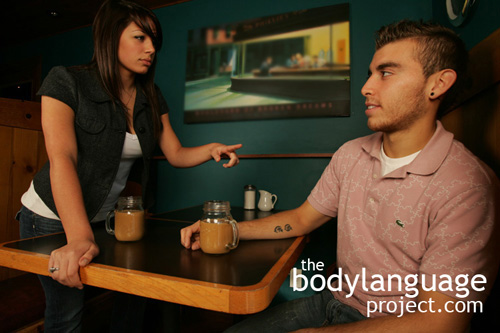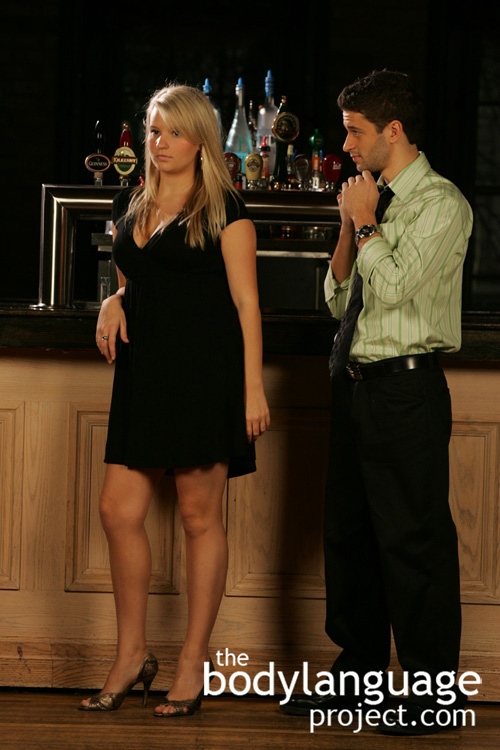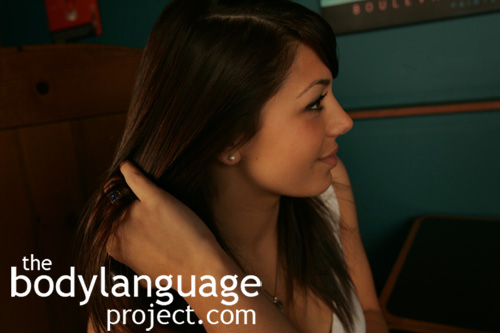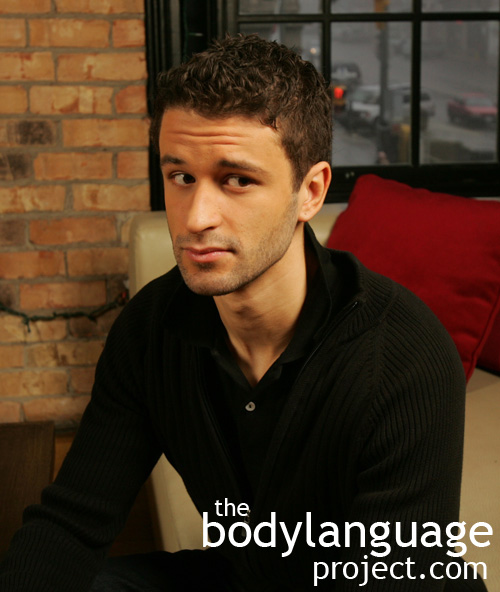Body Language of Jabbing The Finger
Synonym(s): Finger Jabbing, Foot Jabbing
Description: A type of finger pointing but with added emphasis and direction, usually aimed at a person who is being spoken to, and repeated rhythmically. At times, a finger might actually physically make contact with another person to make the cue more salient.
In One Sentence: Finger jabbing is a rude gesture symbolizing being poked by a spear.
How To Use it: Use finger jabbing when you want to use nonverbal aggression to make a point. Jabbing the finger with every point tells others that you should be taken seriously through force and intimidation. In an emotionally charged debate one can use the finger jab to drive your point home.
On the other hand, to appear more rational, drop the finger jab and instead use a calm voice and fluid hand movements to make a proper “point.”
Context: General.
Verbal Translation: “I trying to make a point that I feel strongly about. I’m jabbing my fingers toward you like I would jab a spear. I really want to drive my idea home.”
Variant: The feet are sometimes jabbed or kicked in the direction of other people or during heated situations. Other times, a finger only points in the direction of another person and lacks a jabbing motion. Also see Baton Gesture.
Cue In Action: It was nearing blows. They both exclaimed their case with extreme enthusiasm. At one point, she was shouting and jabbing at close quarters and encroaching on his personal space.
Meaning and/or Motivation: Finger jabbing is a rude gesture. It is as if the person is being stabbed with a spear, especially if is present in a particularly negative or heated context. The voracity and amplitude of the jab outlines the degree of emotion present.
Other times, a jab can be a playful expression between say an uncle and his nephew to tickle his sides and have him giggle.
Cue Cluster: Expect to see violations of personal space, loud voices and shouting, wide focus intense eyes, erratic arm movements, puffing of the chest, arms akimbo and chin jutting.
Body Language Category: Amplifier, Aggressive body language, Body pointing, Displacement behaviour, Enthusiasm (nonverbal), Hostile body language, Intention movements, Negative body language, Threat displays.
Resources:
Axtell, Roger E. Gestures: The Do’s and Taboos of Body Language Around the World. 1997. Wiley.
Anderson, C. A., & Bushman, B. J. (2002). Human aggression. Annual Review of
Psychology, 53, 27–51. http://dx.doi.org/10.1146/annurev.psych.53.100901.
135231.
Arsenio, W. F., Cooperman, S., & Lover, A. Affective Predictors of Preschooler’s Aggression and Peer Acceptance: Direct and Indirect Effects. Developmental Psychology. 2000. 36: 438-448.
LINK yyyy
App, Betsy; Catherine L. Reed and Daniel N. McIntosh. Relative Contributions Of Face And Body Configurations: Perceiving Emotional State And Motion Intention. Cognition and Emotion. 2012. 26(4): 690-698.
http://bodylanguageproject.com/articles/facial-expressions-versus-bodily-expressions-nonverbal-communication/
Arsenio, W. F., Cooperman, S., & Lover, A. Affective Predictors of Preschooler’s Aggression and Peer Acceptance: Direct and Indirect Effects. Developmental Psychology. 2000. 36: 438-448.
Bjorkqvist, K., Osterrnan, K. and Lagerspetz, K.M.I. (1994) ‘Sex Differences in Covert
Aggression among Adults’, Aggressive Behaviour 20: 27–33.
Anderson, J. (1972). “Attachment Behavior Out of Doors.” In N. G. Blurton Jones (Ed.), Ethological Studies of Child Behaviour (Cambridge: University Press), pp. 199-215.
Bruner, J. (1978). “On Prelinguistic Prerequisites of Speech.” In R. N. Campbell and P. T. Smith, eds., Recent Advances in the Psychology of Language (New York: Plenum Press), pp. 199-214.
Call, B., Hare, B., & Tomasello, M. (1998). Chimpanzee gaze following in an object-choice task. Animal Cognition, 1, 89–99.
Behne, T., Carpenter, M., & Tomasello, M. (2005). One-Year-Olds Comprehend The Communicative Intentions Behind Gestures In A Hiding Game. Developmental Science, 8, 492–499.
Broth, Mathias and Lorenza Mondada. Walking Away: The Embodied Achievement of Activity Closings in Mobile Interaction. Journal of Pragmatics. 2013. 47: 41-58.
http://bodylanguageproject.com/articles/nonverbally-negotiate-conversation-walking-away/
Ekman, Paul, and Wallace V. Friesen (1969b). “The Repertoire of Nonverbal Behavior: Categories, Origins, Usage, and Coding.” In Semiotica (Vol. 1), pp. 49-98.
Freedman, Norbert ; Blass, Thomas ; Rifkin, Arthur ; Quitkin, Frederic Lanzetta, John T. (editor). Body movements and the verbal encoding of aggressive affect. Journal of Personality and Social Psychology. 1973. 26(1): 72-85.
Gräfenhaina, Maria; Tanya Behnea; Malinda Carpentera; and Michael Tomaselloa. One-Year-Olds’ Understanding Of Nonverbal Gestures Directed To A Third Person. Cognitive Development. 2009. 24: 23-33. http://bodylanguageproject.com/articles/origins-nonverbal-communication-body-language-infants-study/
Gray, Hilary (1978). “Learning to Take an Object from the Mother.” In Andrew Lock, ed., Action, Gesture and Symbol: The Emergence of Language (New York: Academic Press), pp. 159-82.
Hatz, Jessica L. and Martin J. Bourgeois. Anger as a Cue to Truthfulness. Journal of Experimental Social Psychology. 2010. 46: 680-683.
http://bodylanguageproject.com/articles/anger-nonverbal-cue-truth-telling/
Hubbard, J. A. Emotion expression processes in children’s peer interaction: The role of Peer Rejection, Aggression, and Gender. Child Development. 2001. 72: 1426-1438.
Hubbard, J. A., Smithmyer, C. M., Ramsden, S. R., Parker, E. H., Flanagan, K. D., Dearing, K. F., Relyea, N., & Simons, R. F. Observational, Physiological, and Self-Reported Measures of Children’s Anger: Relations to Reactive Versus Proactive
Aggression. Child Development. 2002. 73, 1101-1118.
Hines, N.J. and Fry, D.P. (1994) ‘Indirect Modes of Aggression among Women of Buenos Aires, Argentina’, Sex Roles 30: 213–24.
Johnson, Richard R. and Jasmine L. Aaron. Adults’ Beliefs Regarding Nonverbal Cues Predictive of Violence. Criminal Justice and Behavior. 2013. 40 (8): 881-894. DOI: 10.1177/0093854813475347.
http://bodylanguageproject.com/articles/wanna-fight-nonverbal-cues-believed-indicate-violence
Kret, M. E. and B. de Gelder. When a Smile Becomes a Fist: The Perception of Facial and Bodily Expressions of Emotion in Violent Offenders. Exp Brain Res. 2013. 228: 399-410. DOI 10.1007/s00221-013-3557-6.
http://bodylanguageproject.com/articles/reading-bodily-postures-facial-expressions-incorrectly-can-disastrous-just-ask-violent-offenders/
Lagerspetz, K.M.J., Bjorkqvist, K. and Peltonen, T. (1988) ‘Is Indirect Aggression Typical of Females? Gender Differences in Aggressiveness in 11- to 12-year-old Children’, Aggressive Behavior 14: 403–14.
Marsh, Abigail A; Henry H. Yu; Julia C. Schechter and R. J. R. Blair. Larger than Life: Humans’ Nonverbal Status Cues Alter Perceived Size. PLoS ONE. 2009. 4(5): e5707. doi:10.1371/journal.pone.0005707. http://bodylanguageproject.com/articles/large-life-nonverbal-dominance-affects-perception-size/
Marsh, Abigail A; Karina S. Blair; Matthew M. Jones; Niveen Soliman, and R. J. R. Blair. Dominance and Submission: The Ventrolateral Prefrontal Cortex and Responses to Status Cues Journal of Cognitive Neuroscience. 2009. 21:4, pp. 713–724.
Murphy, Catherine M. (1978). “Pointing in the Context of a Shared Activity.” In Child Development (Vol. 49), pp. 371-80.
Morris, Desmond (1994). Bodytalk: The Meaning of Human Gestures (New York: Crown Publishers).
Núria Esteve-Gibert and Pilar Prieto. Infants Temporally Coordinate Gesture-Speech Combinations Before They Produce Their First Words. Speech Communication. 2014; 57 301-316.
http://bodylanguageproject.com/articles/pointing-is-infants-first-communicative-gesture/
Olson, Loreenn. ; Braithwaite, Dawno. If you hit me again, I’ll hit you back:” Conflict management strategies of individuals experiencing aggression during conflicts.
Communication Studies. 2004 55(2): 271-285.
Okken, Vanessa ; Van Rompay, Thomas ; Pruyn, Ad. Room to Move: On Spatial Constraints and Self-Disclosure During Intimate Conversations. Environment and Behavior. 2013. 45(6): 737-760.
Sell, A., Tooby, J., and Cosmides, L. Formidability and the Logic of Human Anger. Proceedings of the National Academy of Science. 2009. 106(35), 15073-78
Sinke, C.B, Sorger, B, Goebel, R, and de Gelder, B. Tease or Threat? Judging Social Interactions From Bodily Expressions. Neuroimage. A Journal of Brain Function. 2009. 49:1717-1727. doi: 10.1016/j.neuroimage.
http://bodylanguageproject.com/articles/friend-foe-let-body-language-decide
Sun Jung, Hyo Sun and Hye Hyun Yoon. The Effects of Nonverbal Communication of Employees in the Family Restaurant Upon Customers’ Emotional Responses and Customer Satisfaction. International Journal of Hospitality Management. 2011. 30: 542-550.
http://bodylanguageproject.com/articles/effect-body-languagel-cues-family-restaurant/
Sell, A., Cosmides, L. and Tooby, J., The Human Anger Face Evolved to Enhance Cues of Strength. Evolution and Human Behavior. 2014, doi: 10.1016/j.evolhumbehav.2014.05.008
http://bodylanguageproject.com/articles/human-anger-face-signal-strength
Topel, Eva-Maria ; Lachmann, Frankm. Nonverbal Dialogues: Orienting and Looking Behaviors Between Aggressive and Violent Children and Adolescents and Their Therapist. Journal of Infant, Child, and Adolescent Psychotherapy. 2007. 6(4): 285-307.
Trevarthen, Colwyn (1977). “Descriptive Analysis of Infant Communicative Behaviour.” In H. R. Schaffer, ed., Studies in Mother-Infant Interaction (London: Academic Press), pp. 227-70.
van der Goot, Marloes H.; Michael Tomasello and Ulf Liszkowski. Differences in the Nonverbal Requests of Great Apes and Human Infants. Child Development. 2014. 85(2): 444–455.
http://bodylanguageproject.com/articles/body-language-pointing-human-infants-point-manipulate-apes-point-reach/









